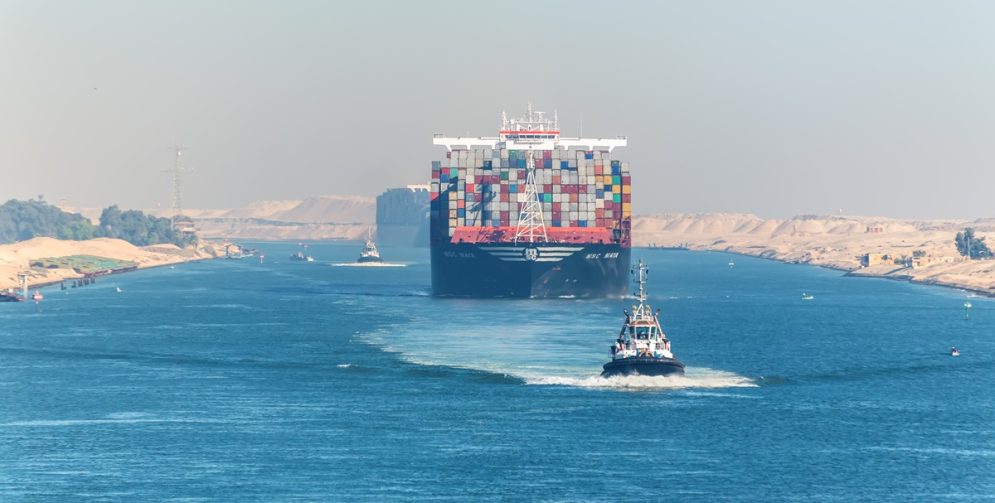Written by Céline Bacrot and Marc-Antoine Faure, Article No. 118 [UNCTAD Transport and Trade Facilitation Newsletter N°101 – First Quarter 2024]
The end of 2023 and the first quarter of 2024 are marked by major disruptions to global maritime trade flows as ships entering the Gulf of Aden and sailing through the Red Sea and the Suez Canal continue to face attacks by Yemen-based Houthis.[1] This new wave of disruption follows the unprecedented global logistics crunch caused by the COVID-19 pandemic and its fallout in 2020-2022 and the war in Ukraine since 2022. It also compounds the challenges caused by the reduced ship transits in the Panama Canals resulting from the impact of drought on water levels.
Security threats in the Red Sea have caused a significant redirection of ship arrivals and transits culminating in far-reaching global trade and transport repercussions. Ships across all shipping segments on the Asia-Europe and Asia-Atlantic trade lane have diverted their initial trajectory and started sailing around Africa’s Cape of Good Hope. As a result, ships are now travelling longer distances and facing higher operational costs. The rerouting of vessels is creating pressure on the supply side. The 12 days in additional sailing time for a vessel going from Shanghai to Rotterdam[2] are driving up costs and extending delays.
The Red Sea crisis has also impacted African ports and causing congestion as rerouting entails the need for more vessels to call at African ports including for bunkering services. Yet, these ports are not always fully prepared to service additional ship calls and cater to larger vessels.
The disruption in the Red Sea and increased shipping traffic around Africa underscore the need for African countries and ports to scale up ongoing efforts aimed at implementing trade facilitation measures, taking up digitalization and mainstreaming green processes to reduce port congestion and expedite the clearance of goods.
The 2020-2022 upheaval in global logistics and the war in Ukraine have exposed the vulnerability of extended supply chains to disruptions and exposed instances of ill preparedness. The Red Sea crisis and the Panama Canal situation are further emphasizing the need to strengthen transport and trade in the face of disruption and consider how to respond, cope, recover and adapt to the new operating conditions.
In this context, a key question arises: Can African countries leverage the current disruption and explore how, by improving their trade facilitation environment, they can take advantage of the business opportunities that may arise from the additional traffic passing through their ports?
Put differently, could the additional port calls that are currently mostly motivated by bunkering activities stimulate maritime trade? Could the additional port activities motivate additional imports and exports?[3]
In times of crisis, as shown during the COVID-19 pandemic and the war in Ukraine, strengthening the trade facilitation ecosystem is key to keeping trade flowing by reducing port congestion and building the resilience of the border agencies. While, at this stage, it is difficult to measure the long-term impact of the Red Sea crisis on the African economies, it is likely that the unexpected increase in shipping traffic around Africa and higher demand for port and bunkering services will impact port activities and performance. Increased port calls that boost the maritime business could stimulate African economies while at the same time incentivise implementation of trade facilitation measures to expedite the clearance of goods. Examples of such measures include the digitalization of trade procedures and investment in hinterland infrastructure and services along transport and trade corridors.
Short-term Impact and Windfall Effects
The Suez Canal is a global strategic waterway that enables the crossing of 10% of global seaborne trade by volume[4] and 22% of containerized trade flows.[5] The Red Sea shipping crisis is putting considerable strain on international trade, regional stability, and economic recovery, against a backdrop of inflationary pressure and macroeconomic uncertainty.[6]
For African trade, the disruption of the Suez Canal is of significant importance since the European market is the most important trading partner accounting for 26% of all imports in terms of value into African countries, and the first destination market for 26% of all African exports in terms of value.[7] Foreign trade for several East African countries is highly dependent on the Suez Canal. It is estimated that approximately 31% of foreign trade by volume for Djibouti is channelled through the Suez Canal. For Kenya, the share is 15%, and for Tanzania it is 10%. Foreign trade for the Sudan depends the most on the Suez Canal, with about 34% of its trade volume crossing the Canal.[8] As of today, the disruption of the Suez Canal has created shortage of not only perishable but also and normal containers due to the increased cargo delivery time such as such as avocado in East Africa but also tea and coffee supply chains.[9]
Rerouting vessels around the African continent add about 12 days to the ship journey on a route from Asia to Europe and acts as a negative supply shock equivalent to a roughly 30% increase in transit times. Extended travel distances and transit times are estimated to cut effective global container shipping capacity by around 9%.[10] Indeed, a round trip between India and Europe, for example, takes 56 days and 8 ships. If the journey takes 63 days, an extra ship will be needed.[11]The reduction in vessel transits through the Suez Canal is massive, with a fall of 42% compared with the peak in 2023.[12] The shift from the Gulf of Aden to the Cape of Good Hope is therefore striking: the tonnage of ships entering the Gulf of Aden fell by more than 70% between the first half of December 2023 and the first half of February 2024. Meanwhile, by the first week of March 2024, the gross tonnage of vessels arriving at the Cape of Good Hope has increased by 85% (7-day moving average) compared to the first half of December 2023).


Hi, this is a comment.
To get started with moderating, editing, and deleting comments, please visit the Comments screen in the dashboard.
Commenter avatars come from Gravatar.